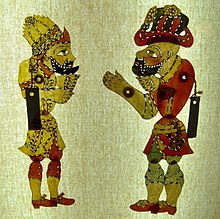Hacivat Karagöz Neden Öldürüldü?
| Karagöz | |
|---|---|

Hacivat (left) and Karagöz (right)
|
|
| Country | Turkey |
| Reference | 180 |
| Region | Anatolia |
| Inscription history | |
| Inscription | 2009 (4th session) |
Karagöz (meaning blackeye in Turkish) and Hacivat (shortened in time from "Hacı İvaz" meaning "İvaz the Pilgrim", and also sometimes written as Hacivad) are the lead characters of the traditional Turkish shadow play, popularized during the Ottoman period and then spread to most nation states that comprised the Ottoman Empire and most prominently in Turkey and Greece. In Greece, Karagöz is known by his local name Karagiozis; in Bosnia-Herzegovina, he is known by his local name Karađoz or Karadjoz.
The central theme of the plays are the contrasting interaction between the two main characters. They are perfect foils of each other: in the Turkish version Karagöz represents the illiterate but straightforward public, whereas Hacivat belongs to the educated class, speaking Ottoman Turkish and using a poetical and literary language. Although Karagöz has definitely been intended to be the more popular character with the Turkish peasantry, Hacivat is always the one with a level head. Though Karagöz always outdoes Hacivat’s superior education with his "native wit," he is also very impulsive and his never-ending deluge of get-rich-quick schemes always results in failure. In the Greek version Hacivat (Hatziavatis) is the more educated Turk who works for the Ottoman state, and often represents the Pasha, or simply law and order, whereas Karagöz (Karagiozis) is the poor peasant Greek, nowadays with Greek-specific attributes of the raya.
Hacivat continually attempts to “domesticate” Karagöz, but never makes progress. According to Turkish dramaturge Kırlı, Hacivat emphasizes the upper body with his refined manners and aloof disposition, while Karagöz is more representational of “the lower body with eating, cursing, defecation and the phallus." Other characters in the plays are different ethnic characters living under Ottoman domain such as (in the Turkish version) Armenians, Albanians, Greeks, Franks, and Arabs, each with their unique, stereotypical traits. In the Greek version new characters have been introduced or altered: the Pasha, the daughter of the Vezir (both representing the state, the latter being very beautiful and courted unsuccessfully by Karagöz (Karagiozis), Barba-Giorgos (the enormous Roumeliot shepherd who acts as an uncle to Karagöz), the Morfonios (beautiful) with the enormous nose (adapted from a previous Ottoman character), Velingekas (the policeman who represents the Ottoman state but has his own macho honor code) as well as inventions such as Stavrakas (the Piraeot Rebet, macho character) and his Rebetiko band, Nionios from Zante, the Cretan, the Jew (adapted from the Ottoman character).
...
Wikipedia
